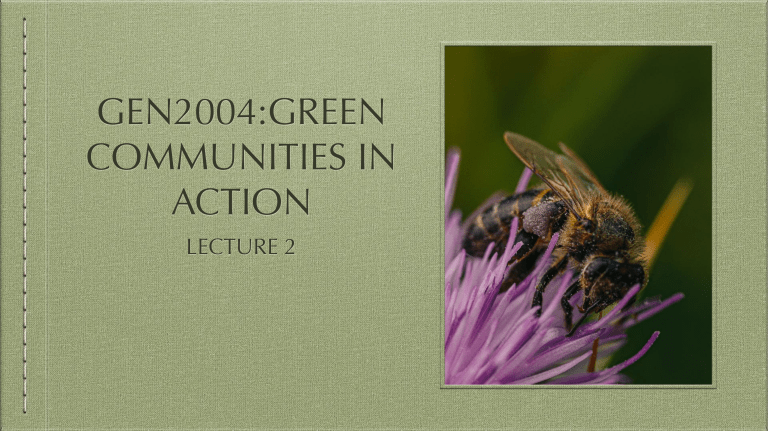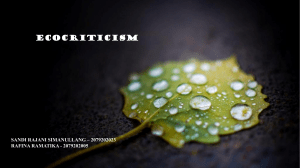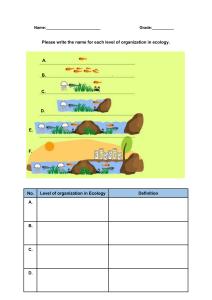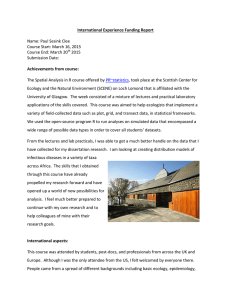
GEN2004:GREEN COMMUNITIES IN ACTION LECTURE 2 In this Lecture… Environmental Humanities – It’s beginnings and importance Some schools within Environmental Humanities Deep and Shallow Ecologies Also in this Lecture.. In the second part of the lecture we will be looking at: Key Ecocritical Tropes Critical Reading 1: “Literature and the Environment” by Lawrence Buell, Ursula K. Heise, and Karen Thornber Environmental Humanities As we discussed in lecture 1, Environmental Humanities is an interdisciplinary field which began with scholars concerned that the facts about our ecological crisis had not filtered down to the masses. It draws on many sub-disciplines within the humanities. These include: Ecocriticism—literary studies that relate to the environment in subtle and overt ways Environmental history—notes and narrates human relationship with nonhuman to deepen our understanding of major environmental events and how humans have been affected and effect the natural environment over time Environmental anthropology—which studies human relations with the environment Environmental philosophy—focusses on the moral relationship between human beings and nature And so on…. Environmental Humanities The Environment has always concerned humans. ‘Nature’ has traditionally been idealised yet othered in human history. However, with the emergence of global warming and the environmental crisis due to questionable human activities, these investigations took centre stage from around the 1970s. Suddenly, it was clear that it was insufficient for environmental scientists to sit around sharing data about our impending global crisis if we needed to survive this crisis as a species. Ecocriticism Thus, many literary scholars, philosophers and historians became actively engaged with the climate question. We have ‘ecological critics’ or ecocritics, who raised awareness about human exploitation of nonhuman nature and the gradual ecological degradation. These scholars diligently flagged up the nature/culture binary, siding with Nature. Greg Garrard in his Ecocriticism (2004) calls it “an avowedly political mode of analysis” (3). But to balance this view, one needs to also acknowledge that in the First Wave, there was also a great deal of ‘romanticising of Nature’. The Second Wave In The Future of Environmental Criticism (2005), Lawrence Buell distinguishes between the First and Second waves: Difference in 20-21st century 4 Twentieth Century environmental criticism was mostly engaged in analysing nature writing, wilderness, and with American Romantic traditions. The emerging works in the 21st century are now increasingly concerned with topical environmental issues that are hard hitting, political and involves gender, urban and class issues. E.g. Rob Nixon's Slow Violence: Environmentalism of the Poor We must remember that these waves are not entirely distinct and do sometime overlap. For example, the emphasis on environmental activism is a part of both waves. The Second Wave The second wave was more interdisciplinary. - It politicised and challenged the very binaries that the first wave took for granted such as Nature/Culture. It questioned many institutions for the role they have played in the exploitation of nature. It questioned government policies on mining, use of fossil fuels, large-scale deforestation and other environmentally exploitative acts. Scholars also questioned intellectual movements and ideological structures Institutions and Ideologies under Scrutiny in the Second Wave Humanism: Placing ‘Man’ at the centre of created life. Colonialism: ‘Civilising landscapes’; outsourcing resources; plantation culture Patriarchy: Conflating women and nature – constructing them both as passive and hence as ‘requiring’ to be lorded over. Classism: Richer nations of the world have pushed their ‘dirty’ industries to the poorer nations. Modernity and Globalisation: The role of capitalism in modernisation and how globalisation has increased exploitative practices The Second Wave Some of the most complexly theorised subfields are: Ecofeminism Postcolonial Ecologies We will be examining both these subfields in detail in the coming weeks. Let’s now look into a seminal environmental philosophy that underpins several others called Deep Ecology. > ~ Philosophy Deep Ecology Deep Ecology is an environmental philosophy that believes that humans need to change their attitude and relationship to nonhuman nature. As a social, activist movement, it advocates for a non-anthropocentric, non-utilitarian approach to nonhuman Nature. It insists on the inherent worth of all life forms on earth. As a social movement it sometimes carries both mystical and religious undertones. Norwegian philosopher Arne Naess (1912-2009) was one of its main proponents. Deep Ecology > - Beginning The publication of Rachel Carson's Silent Spring (1962) is often regarded as the beginning of the contemporary deep ecology movement. The book documented the environmental harm caused by the indiscriminate use of pesticides and accused the chemical industry and public officials of spreading misinformation. What is Deep Ecology? EThe basic principles, tenets and beliefs of Deep Ecology:7 Within the Earth’s biosphere, all lives are interconnected and live in mutual interdependence. Human and non-human life on earth have value in themselves. Humans have no right to reduce the diversity of nature except to satisfy vital needs. Deep Ecologists favour a more spiritual consciousness and they ask for voluntary simplicity in living and a non-exploitive steady-state economy. The flourishing of human life and cultures as well as non-human life is compatible with a substantial decrease of the human population. Deep Ecology Present human interference with the non-human world is excessive and needs to be curbed through policy change. It pursues “biospheric egalitarianism” (Ramachandra Guha, Global Environmentalism, 116) which believes in the equality of all life forms. Underpinning this strand is the philosophy of biocentrism. Biocentrism does not approve of treating humans as more valuable than the rest of creation. Deep ecologists emphasise the need to move from and Egological model to an Ecological one. They believe that Anthropocentrism must be replaced with Cosmocentrism, reflected in the ecological and ecological models, respectively. Deep Ecology > - Ecocentric Deep ecologists take an ecocentric/cosmocentric, rather than an anthropocentric approach. The term ‘dark green’ is used to describe the beliefs of deep ecologists. Deep ecologists claim that they transcend the short-sighted instrumental pragmatism of the resource management approach to the environmental crisis in favour of an ethic based on the recognition of the intrinsic worth of the nonhuman world. They are in favour of abandoning hard-headed scientific approach. ↳ Abandon science ; radical reform needed Shallow Ecology vs Deep Ecology Shallow ecologists, unlike deep ecologists, believe that humans should only do something if it involves the interests of our species. For example, we should save ecosystems but only if they are of value to us. This suggests a utilitarian and anthropocentric approach to ecology based on materialism and consumerism. Shallow ecology seeks technological solutions to major environmental problems, rather than a change in human behaviour and values. Shallow ecologists adopt a human-centred approach to environmental issues. The term 'light green' has been applied to describe this set of beliefs. Deep versus Shallow Ecologists * Deep Ecology Shallow Ecology Nonhuman nature needs to be saved. Environments of benefit to humans need to be conserved. Nonhuman nature is an autonomous entity. Humans are an exceptional species. Humans have no right to abuse it or assume ownership of nonhuman nature. Nonhuman nature be saved for human benefit. They are ecocentric. They are anthropocentric. All life on planet earth has the right to live its life in Only those aspects of nature that will help human its natural habitat without human interference. species survive need to be saved. Regardless of its utility to humans, nonhuman nature needs to survive. Based on its use to the human species, we can choose what we want to save. They accuse shallow ecologists of being instrumental and shortsighted. They accuse deep ecologists of being hopelessly idealistic and romanticising nature. Representations of Nature Greg Garrard identifies SIX TROPES (Figures of speech like metaphors, similes, based on which concepts are developed by ecocritics, writers, etc.) They are: Pollution Wilderness Pastoral Apocalypse Dwelling Animals Greg Garrard’s Ecocriticism In his book, Ecocriticism, which has come to be widely regarded as a foundational text in the subject, Greg Garrard identifies some common tropes used by conservationists and eco-warriors. What are tropes? A trope is a recurrent theme or motif. These can either be commonly used figures of speech such metaphors or similes or a subject or an idea that pervades the text(s) Each of the chapters of his book focuses on one metaphor, or a collection of heterogenous metaphors, genres, narratives and images, which he identifies as ecocritical ‘tropes’ that are commonly observed in environmental writings. The meaning of tropes is closely related to their wider social context and they constantly evolve historically. Ecocritical Tropes: Pollution The idea of pollution is a central trope in environmental texts, literary and non-literary. “Pollution” as a trope has operated both literally and metaphorically to further conservationist ideology. Derived from the Latin “polluere” meaning to desecrate, dishonour or violate Until the 17th Century, its English usage denoted moral defilement or acts that brought about moral debasement Pollution By the 19th Century, the ‘interiority’ of its meaning was gradually transformed into the ‘exterior’ and became exclusively environmentrelated. ‘Pollution’ now denotes a widely identified ecological problem that represents the normative claim that too much of something is present in the environment, usually in the wrong place without needing to name a substance or class of substances. One of the most effective use of the concept of pollution as a rhetorical device can be seen in Rachel Carson’s The Silent Spring (1962) which is about pesticide poisoning and the consequent threats to wildlife and human life. Photo by Elīna Arāja: https://www.pexels.com/photo/monochromephoto-of-industrial-plant-3401354/ Pastoral The Pastoral is another significant trope for ecocritics. Often references an Edenic “unblemished land” of the past. Romantic Poetry (Wordsworth, Keats, Shelley, Blake) has used the pastoral to establish a contrast with the ‘urban ugliness’ wrought by the Industrial Revolution. Photo by Julia Volk: https://www.pexels.com/photo/brown-cows-on-greengrass-field-5652607/ Pastoral Prominent ecocritic Terry Gifford distinguishes between three kinds of pastoral: The first kind of pastoral is the specific literary tradition. This originated in Ancient Alexandria and became a key poetic form in Europe during the Renaissance. (Wordsworth, Keats, Shelley, Blake, etc.) The second type of pastoral is any literature that describes the country (rural spaces) with an implicit or explicit contrast to the urban. There is also a pejorative sense in which pastoral implies an idealisation of rural life that dilutes/obscures the realities of labour and hardship. All three kinds of pastoral are relevant to Ecocritics. Wilderness The idea of wilderness promotes Nature as pure and uncontaminated. Wilderness, especially in American conservationist writings, holds a sacramental value – “the promise of a renewed, authentic relation of humanity and the earth” (Garrard, 59). Descending from a purely Judaeo-Christian tradition (Jesus in the wilderness), this combines connotations of trial and danger with freedom, redemption and purity. Wilderness The concept of Wilderness came into prominence in the 18th century and is associated with a sublime view of nature. Often speaks of the astonishment evoked by the vastness and overwhelming power of Nature Also observed by ecocritics in non-fictional nature writing— natural history or even philosophy Photo by Francesco Ungaro: https://www.pexels.com/photo/trees-on-a-dark-forest-1671325/ Wilderness William Cronon, a prominent American environmental historian, points out: “Wilderness is the natural, unfallen antithesis of an unnatural civilisation that has lost its soul. It is a place of freedom in which we can recover our true selves we have lost to the corrupting influences of our artificial lives”(1996:80). But this concept of a ‘pure’ wilderness has its problems. Wilderness Very often the wilderness with its sublime invocations are seen as ‘gendered’ with the male portrayed as the domineering ‘tamer’ or inhabiter of the wilderness. Wilderness landscapes are also eroticised in terms of male desire —‘pure’ landscapes, ’virginal land’, ‘rape of the wilderness.’ This concept also suggests that Nature is only pure if it is uninhabited, i.e. empty of humanity and hence can be achieved only at the cost of an elimination of human history. Wilderness & Pastoral Both offer escape from “urban taint” and pollution. But Pastoral is ‘old world’. It refers to a long-settled, domesticated landscapes whereas wilderness is more commonly employed to reflect the settler experience of the New Worlds (USA, Canada, Australia) with “untamed” landscapes. The distinction between country and city in Pastoral is less sharp when compared to Wilderness. Unlike the pastoral, which has both Graeco-Roman and Judaeo-Christian origins, Wilderness is a purely Judaeo-Christian concept. Apocalypse Originated from the Greek Apokalyptein meaning “unveil” Apocalyptic literature takes the form of a revelation at the end of history. As English author and editor Damien Thompson observes: “Apocalypticism has been described as a genre born out of crisis, designed to stiffen the resolve of an embattled community by dangling in front of it the vision of a sudden and permanent release from its captivity. It is underground literature, the consolation of the persecuted” (1997:14). This becomes an invaluable and central trope in ecocritical writings. Apocalypse Types include religious and secular apocalypse . Apocalyptic literature plays into the rhetoric of extinction. Many end-of-time narratives, therefore, talk about the end of humankind, death of nature/habitat, destruction of the planet, etc. As a genre born out of crisis, it is therefore, always proleptic [anticipatory]. It responds to and “recreates” crisis. Reactions evoked can lead to abject fear and eco anxiety. Photo by Алесь Усцінаў : https://www.pexels.com/photo/destroyedresidential-building-11734706 Dwelling/Indigeneity Garrard’s delineation of Dwelling focuses on an “authentic” way of habitation on earth. ‘Stewardship’ over nature, rather than despotism This indicates a harmonious dwelling which causes as little damage to planetary ecologies as is possible. In the third edition of his book he replaces the chapter on dwelling with one titled “Indigeneity” which focusses on the complexities of indigenous cosmologies and practices. Dwelling/Indigeneity Through primarily non-literary writing on the subject, Garrard explores the idea of well-adjusted, native human populations living in harmony with their environments as well as the problems of this stereotype. In order for both humanity and nature to survive, humans need to see themselves as part of a biotic web, as dependent on non-human nature. An awareness of this dependency is what will make human ‘dwelling’ on earth a viable option. Animals Garrard invokes Jeremy Bentham and Peter Singer to elucidate his ideas on Animals as a trope. Jeremy Bentham (1748-1832), an English philosopher, juror and social reformer, in his landmark response to Rene Descartes’ famous “I think therefore I am”, titled “The Animal that therefore I am” says that cruelty to animals was analogous to slavery. He argues, surely a grown dog or a monkey is closer to ‘reason’ than a human baby. Does that exclude the baby from moral considerations? Is it the capacity to feel pain, or the power of reason that entitles a being to moral consideration? How has the Descartesian hyper separation of mind and body, reason and emotion been questioned in writings on animals? Peter Singer in Animal Liberation (1975) draws on Bentham and defines ‘speciesism’ as the “irrational prejudice” that is the basis of our different treatment of animals and humans. Animals As studies of gender, race or (post)colonialism have long shown, our treatment of or relations with other groups and individuals cannot be separated from the concepts we impose on them. As beasts of burden—animals have been put to work; as beasts of demand, they are summoned to respond to the interrogation of science and as beasts of consumption, they have become the meat industry. There is no rationality in cruelty to animals. Animals Need to critically examine the sociocultural (and political) discourse on Animals: While people spend small fortunes on those animals classified as ‘pets’, at the same time every year billions of other nonhuman beings, designated ‘vermin’, ‘livestock’ or scientific ‘specimens’, are in for a very different treatment. Throughout human history, civilisation has always been constructed as a safe haven against the wild, the savage and the animalistic. This Other has always haunted the ‘human’ self—this lends well into colonial ideologies. Human-animal relations have always been a troubled and troubling compound of intimacy and violence, longing and detachment, affection and abjection. The Earth Garrard discusses the use of the Earth as a trope. He talks about Al Gore’s An Inconvenient Truth (documentary for optional viewing). For Gore, satellite images of Earth from space have an unequivocal meaning. It functions as a “rhetorical silver bullet intended to bypass interpretation and argument.” Gore says of ‘Earthrise’: ‘That one picture exploded in the consciousness of humankind.’ Taken aboard Apollo 8 by Bill Anders, this iconic picture shows Earth peeking out from beyond the lunar surface as the first crewed spacecraft circumnavigated the Moon. The power of perspective in conjunction with scientific data Focus on the power of human action in the Age of the Anthropocene Image Credit: NASA Critical Readings: Expected Level of Understanding To reemphasise—the expected level of familiarity with the critical reading is as follows: Need to know the main thesis/es of the article Key data and historical details (highlighted in the lecture slides) Essence of each subsection Main message in the conclusion No need to memorise full quotations Critical Reading: “Literature and the Environment” by Lawrence Buell, Ursula K. Heise, and Karen Thornber Ecocriticism comprises an eclectic, pluriform, and cross-disciplinary initiative that aims to explore the environmental dimensions of literature and other creative media in a spirit of environmental concern not limited to any one method or commitment. It begins on the premise that the arts of imagination and its study—by virtue of their grasp of the power of word, story, and image to reinforce, enliven, and direct environmental concern—can contribute significantly to the understanding of environmental problems. It emphasises the impetus of creative imagination. “Literature and the Environment”: Landmark organisations The Association for the Study of Literature and Environment (ASLE, established in 1992) (http://www.asle.org) and its its flagship journal ISLE: Interdisciplinary Studies in Literature and Environment A worldwide movement with chapters throughout Europe, East, South and Southeast Asia, and Australia-New Zealand. We have our very own ASLE-ASEAN which provides a useful platform to facilitate dialogue between academics, scholars from ecological humanities and ecocritics from different nations within ASEAN. https://aseanasle.wordpress.com/ It has it’s own flagship journal called The Journal of Southeast Asian Ecocriticism hosted by the Dept. of Eng, Linguistics and Theatre Studies. https://fass.nus.edu.sg/elts/ journal-of-southeast-asian-ecocriticism/ “Literature and the Environment”: Ecocriticism’s development Influential studies of pastoral traditions (Leo Marx and Raymond Williams) in American and British literatures in their ecohistorical contexts spotlighted literature as crucial to understanding the environmental transformations of urbanisation and techno-modernity. Ecocriticism’s early concentration was on the pastoral imagination on Anglo-American Romanticism, on lyric poetry in the tradition of William Wordsworth (1770–1850) and his Anglo-American successors, and on literary nature writing from Thoreau to the present. This coincided with the the Industrial Revolution (1760-1840) and led into later work on environmental philosophy and politics of genre, place, region, and nation. “Literature and the Environment”: Imagination of Place The concept of place has always been of central interest to literatureenvironment studies—exploring the interconnectedness between human life/history and physical environments on works of imagination (in all media, including literature). First-wave ecocriticism attached special value to the aesthetics and ethics of place-attachment at a local or regional scale particularly focussing on exurban (inner suburban) areas (for instance pastoral/farmlands, wilderness). This was followed by a shift that began around the start of this century toward greater prioritisation of metropolitan or industrial landscapes. “Literature and the Environment”: Imagination of Place Environmentalism had defined itself from the beginning as a global as well as local mode of thought through its appeal to the “Blue Planet” image of Earth from outer space and its slogan “Think globally, act locally.” Public discussion of global environmental problems such as biodiversity loss and climate change made obvious the need for ecocritical discourse to develop new ways of addressing global interconnectedness and less obvious the idea that local place or region was the only or best way to do this. Environmental justice ecocriticism, which sought to show the structural links between social and environmental problems gradually began to include fights for environmental resources and health elsewhere in the world, and not just America, even though it continued to highlight the primacy of the local. “Literature and the Environment”: Literature, Science, Environment Ecocriticism’s relationship to the natural sciences has always been an ambivalent one. Ecocritics, rely on the insights of biologists, ecologists, and chemists as the basis for their claims about the state of nature, and research findings from the natural sciences provide much of the social legitimation for conservation efforts. But some ecocritics also see science and technology as root causes of ecological crisis, both in reducing nature to a mere object to be studied and manipulated by a detached observer, and in amplifying people’s ability to inflict damage on nature. However, there are examples where science and storytelling have blended seamlessly to produce the desired results (e.g: Ishimure Michiko’s Paradise in the Sea of Sorrow (1969)) on the suffering of victims of Minamata Disease, an epidemic of mercury poisoning caused by toxic waste disposal in Japan between the 1950s and the 1970s) The fusion of different epistemologies may be precarious but ultimately necessary for an altered relationship between humans and their environments in an increasingly globalised world. “Literature and the Environment”: Gender Ecofeminist discourse generally argues that the exploitation of nature and that of women are intimately linked, with some ecofeminists claiming “a parallel in men’s thinking between their ‘right’ to exploit nature, on the one hand, and the use they make of women, on the other.” Grounded in ecological feminist thought, ecofeminist literary criticism can be broadly understood as politically engaged discourse that analyses conceptual connections between the manipulation of women and the nonhuman. “Literature and the Environment”: (Post)colonialism The increased attention to non-Western literatures is one of the most exciting new developments in environmental criticism. Increased scholarly interest in how creative texts from Africa, Latin America, and Asia discuss the environmental aspects of (post)colonialism Recent ecocriticism scrutinises more intensively the relationships between imperialism and ecological distress. Postcolonial ecocriticism has contributed significantly to the “Worlding” of environmental criticism. “Literature and the Environment”: Indigeneity Native artists’ storytelling practices and underlying mythographies have been recorded by ethnographers and nature writers to study the dynamics of long-term collective attachment to specific locales. These are important for their potential adaptability as models for contemporary artistic and life practices, e.g., for their insights into the challenges of sustaining or restoring ecocultural identity and non-dualistic recognition within “native” peoples’ collective imagination and sensory awareness of nonhuman entities as fellow beings. Recognise indigenous art and thought for its testaments to multiple forms of environmental injustice and resistance, e.g., land grabs, exploitative labor practices, racist marginalisation, etc. “Literature and the Environment”: Imagining Nonhumans Conservation efforts in Western societies have typically focused on the protection of: habitats and species—two elements that symbolically stand in for the protection of nature at large “Biophilia” is the sense of human connectedness to nonhuman living beings. Ecocriticism has found a rich territory for investigation in the abundant literature on animals in both Western and non-Western traditions. It opens up a posthumanist perspective on humans as one species among others rather than one with special privileges “Literature and the Environment”: Conclusion Whether or not ecocriticism moves toward tighter consensus about questions of purpose and method or continues to remain a more loosely networked in terms of initiatives and provocations, it has succeeded in focalising the environment as a pressing priority beyond the parameters of literature studies. And, it has generated a number of specific critical approaches that offer the promise of a deeper, more nuanced grasp of environmental issues. Thank you for your attention.



